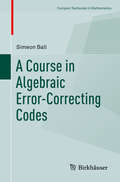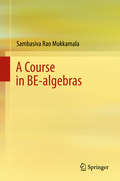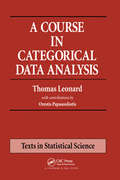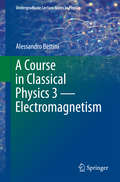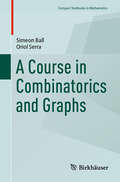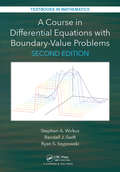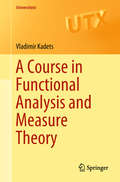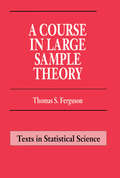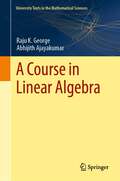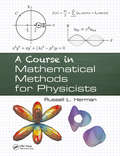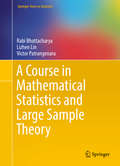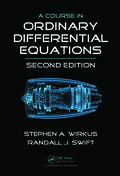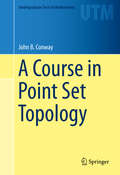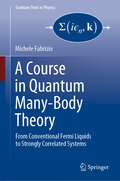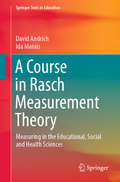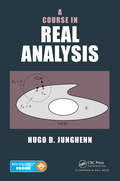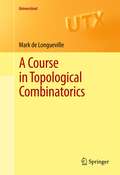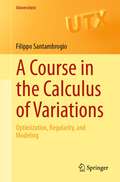- Table View
- List View
A Course in Algebraic Error-Correcting Codes (Compact Textbooks in Mathematics)
by Simeon BallThis textbook provides a rigorous mathematical perspective on error-correcting codes, starting with the basics and progressing through to the state-of-the-art. Algebraic, combinatorial, and geometric approaches to coding theory are adopted with the aim of highlighting how coding can have an important real-world impact. Because it carefully balances both theory and applications, this book will be an indispensable resource for readers seeking a timely treatment of error-correcting codes. Early chapters cover fundamental concepts, introducing Shannon’s theorem, asymptotically good codes and linear codes. The book then goes on to cover other types of codes including chapters on cyclic codes, maximum distance separable codes, LDPC codes, p-adic codes, amongst others. Those undertaking independent study will appreciate the helpful exercises with selected solutions. A Course in Algebraic Error-Correcting Codes suits an interdisciplinary audience at the Masters level, including students of mathematics, engineering, physics, and computer science. Advanced undergraduates will find this a useful resource as well. An understanding of linear algebra is assumed.
A Course in BE-algebras
by Sambasiva Rao MukkamalaThis book presents a unified course in BE-algebras with a comprehensive introduction, general theoretical basis and several examples. It introduces the general theoretical basis of BE-algebras, adopting a credible style to offer students a conceptual understanding of the subject. BE-algebras are important tools for certain investigations in algebraic logic, because they can be considered as fragments of any propositional logic containing a logical connective implication and the constant "1", which is considered as the logical value “true”. Primarily aimed at graduate and postgraduate students of mathematics, it also helps researchers and mathematicians to build a strong foundation in applied abstract algebra. Presenting insights into some of the abstract thinking that constitutes modern abstract algebra, it provides a transition from elementary topics to advanced topics in BE-algebras. With abundant examples and exercises arranged after each section, it offers readers a comprehensive, easy-to-follow introduction to this field.
A Course in Categorical Data Analysis (Chapman And Hall/crc Texts In Statistical Science Ser. #45)
by Thomas LeonardCategorical data-comprising counts of individuals, objects, or entities in different categories-emerge frequently from many areas of study, including medicine, sociology, geology, and education. They provide important statistical information that can lead to real-life conclusions and the discovery of fresh knowledge. Therefore, the ability to manipulate, understand, and interpret categorical data becomes of interest-if not essential-to professionals and students in a broad range of disciplines. Although t-tests, linear regression, and analysis of variance are useful, valid methods for analysis of measurement data, categorical data requires a different methodology and techniques typically not encountered in introductory statistics courses. Developed from long experience in teaching categorical analysis to a multidisciplinary mix of undergraduate and graduate students, A Course in Categorical Data Analysis presents the easiest, most straightforward ways of extracting real-life conclusions from contingency tables. The author uses a Fisherian approach to categorical data analysis and incorporates numerous examples and real data sets. Although he offers S-PLUS routines through the Internet, readers do not need full knowledge of a statistical software package.In this unique text, the author chooses methods and an approach that nurtures intuitive thinking. He trains his readers to focus not on finding a model that fits the data, but on using different models that may lead to meaningful conclusions. The book offers some simple, innovative techniques not highighted in other texts that help make the book accessible to a broad, interdisciplinary audience. A Course in Categorical Data Analysis enables readers to quickly use its offering of tools for drawing scientific, medical, or real-life conclusions from categorical data sets.
A Course in Classical Physics 3 -- Electromagnetism: Electromagnetism (Undergraduate Lecture Notes in Physics)
by Alessandro BettiniFocusing on electromagnetism, this third volume of a four-volume textbook covers the electric field under static conditions, constant electric currents and their laws, the magnetic field in a vacuum, electromagnetic induction, magnetic energy under static conditions, the magnetic properties of matter, and the unified description of electromagnetic phenomena provided by Maxwell's equations. The four-volume textbook as a whole covers electromagnetism, mechanics, fluids and thermodynamics, and waves and light, and is designed to reflect the typical syllabus during the first two years of a calculus-based university physics program. Throughout all four volumes, particular attention is paid to in-depth clarification of conceptual aspects, and to this end the historical roots of the principal concepts are traced. Emphasis is also consistently placed on the experimental basis of the concepts, highlighting the experimental nature of physics. Whenever feasible at the elementary level, concepts relevant to more advanced courses in quantum mechanics and atomic, solid state, nuclear, and particle physics are included. The textbook offers an ideal resource for physics students, lecturers and, last but not least, all those seeking a deeper understanding of the experimental basics of physics.
A Course in Combinatorics
by J. H. van LintThis is the second edition of a popular book on combinatorics, a subject dealing with ways of arranging and distributing objects, and which involves ideas from geometry, algebra and analysis. The breadth of the theory is matched by that of its applications, which include topics as diverse as codes, circuit design and algorithm complexity. It has thus become essential for workers in many scientific fields to have some familiarity with the subject. The authors have tried to be as comprehensive as possible, dealing in a unified manner with, for example, graph theory, extremal problems, designs, colorings and codes. The depth and breadth of the coverage make the book a unique guide to the whole of the subject. The book is ideal for courses on combinatorical mathematics at the advanced undergraduate or beginning graduate level. Working mathematicians and scientists will also find it a valuable introduction and reference.
A Course in Combinatorics and Graphs (Compact Textbooks in Mathematics)
by Simeon Ball Oriol SerraThis compact textbook consists of lecture notes given as a fourth-year undergraduate course of the mathematics degree at the Universitat Politècnica de Catalunya, including topics in enumerative combinatorics, finite geometry, and graph theory. This text covers a single-semester course and is aimed at advanced undergraduates and masters-level students. Each chapter is intended to be covered in 6-8 hours of classes, which includes time to solve the exercises. The text is also ideally suited for independent study. Some hints are given to help solve the exercises and if the exercise has a numerical solution, then this is given. The material covered allows the reader with a rudimentary knowledge of discrete mathematics to acquire an advanced level on all aspects of combinatorics, from enumeration, through finite geometries to graph theory. The intended audience of this book assumes a mathematical background of third-year students in mathematics, allowing for a swifter useof mathematical tools in analysis, algebra, and other topics, as these tools are routinely incorporated in contemporary combinatorics. Some chapters take on more modern approaches such as Chapters 1, 2, and 9. The authors have also taken particular care in looking for clear concise proofs of well-known results matching the mathematical maturity of the intended audience.
A Course in Differential Equations with Boundary Value Problems (Textbooks in Mathematics)
by Stephen A. Wirkus Randall J. Swift Ryan SzypowskiA Course in Differential Equations with Boundary Value Problems, 2nd Edition adds additional content to the author’s successful A Course on Ordinary Differential Equations, 2nd Edition. This text addresses the need when the course is expanded. The focus of the text is on applications and methods of solution, both analytical and numerical, with emphasis on methods used in the typical engineering, physics, or mathematics student’s field of study. The text provides sufficient problems so that even the pure math major will be sufficiently challenged. The authors offer a very flexible text to meet a variety of approaches, including a traditional course on the topic. The text can be used in courses when partial differential equations replaces Laplace transforms. There is sufficient linear algebra in the text so that it can be used for a course that combines differential equations and linear algebra. Most significantly, computer labs are given in MATLAB®, Mathematica®, and Maple™. The book may be used for a course to introduce and equip the student with a knowledge of the given software. Sample course outlines are included. Features MATLAB®, Mathematica®, and Maple™ are incorporated at the end of each chapter. All three software packages have parallel code and exercises; There are numerous problems of varying difficulty for both the applied and pure math major, as well as problems for engineering, physical science and other students. An appendix that gives the reader a "crash course" in the three software packages. Chapter reviews at the end of each chapter to help the students review Projects at the end of each chapter that go into detail about certain topics and introduce new topics that the students are now ready to see Answers to most of the odd problems in the back of the book
A Course in Financial Calculus
by Alison EtheridgeThis text is designed for first courses in financial calculus aimed at students with a good background in mathematics. Key concepts such as martingales and change of measure are introduced in the discrete time framework, allowing an accessible account of Brownian motion and stochastic calculus. The Black-Scholes pricing formula is first derived in the simplest financial context. Subsequent chapters are devoted to increasing the financial sophistication of the models and instruments. The final chapter introduces more advanced topics including stock price models with jumps, and stochastic volatility. A large number of exercises and examples illustrate how the methods and concepts can be applied to realistic financial questions.
A Course in Finite Group Representation Theory
by Peter WebbThis graduate-level text provides a thorough grounding in the representation theory of finite groups over fields and rings. The book provides a balanced and comprehensive account of the subject, detailing the methods needed to analyze representations that arise in many areas of mathematics. Key topics include the construction and use of character tables, the role of induction and restriction, projective and simple modules for group algebras, indecomposable representations, Brauer characters, and block theory. This classroom-tested text provides motivation through a large number of worked examples, with exercises at the end of each chapter that test the reader's knowledge, provide further examples and practice, and include results not proven in the text. Prerequisites include a graduate course in abstract algebra, and familiarity with the properties of groups, rings, field extensions, and linear algebra.
A Course in Functional Analysis and Measure Theory (Universitext)
by Vladimir Kadets Andrei IacobWritten by an expert on the topic and experienced lecturer, this textbook provides an elegant, self-contained introduction to functional analysis, including several advanced topics and applications to harmonic analysis. Starting from basic topics before proceeding to more advanced material, the book covers measure and integration theory, classical Banach and Hilbert space theory, spectral theory for bounded operators, fixed point theory, Schauder bases, the Riesz-Thorin interpolation theorem for operators, as well as topics in duality and convexity theory.Aimed at advanced undergraduate and graduate students, this book is suitable for both introductory and more advanced courses in functional analysis. Including over 1500 exercises of varying difficulty and various motivational and historical remarks, the book can be used for self-study and alongside lecture courses.
A Course in Large Sample Theory (Chapman And Hall/crc Texts In Statistical Science Ser. #38)
by Thomas S. FergusonA Course in Large Sample Theory is presented in four parts. The first treats basic probabilistic notions, the second features the basic statistical tools for expanding the theory, the third contains special topics as applications of the general theory, and the fourth covers more standard statistical topics. Nearly all topics are covered in their multivariate setting.The book is intended as a first year graduate course in large sample theory for statisticians. It has been used by graduate students in statistics, biostatistics, mathematics, and related fields. Throughout the book there are many examples and exercises with solutions. It is an ideal text for self study.
A Course in Linear Algebra (University Texts in the Mathematical Sciences)
by Raju K. George Abhijith AjayakumarDesigned for senior undergraduate and graduate courses in mathematics and engineering, this self-contained textbook discusses key topics in linear algebra with real-life applications. Split into two parts—theory in part I and solved problems in part II—the book makes both theoretical and applied linear algebra easily accessible. Topics such as sets and functions, vector spaces, linear transformations, eigenvalues and eigenvectors, normed spaces, and inner product spaces are discussed in part I; while in part II, over 500 meticulously solved problems show how to use linear algebra in real-life situations. A must-have book for linear algebra courses; it also serves as valuable supplementary material.
A Course in Mathematical Methods for Physicists
by Russell L. HermanBased on the author's junior-level undergraduate course, this introductory textbook is designed for a course in mathematical physics. Focusing on the physics of oscillations and waves, A Course in Mathematical Methods for Physicists helps students understand the mathematical techniques needed for their future studies in physics. It takes a bottom-u
A Course in Mathematical Statistics and Large Sample Theory (Springer Texts in Statistics)
by Rabi Bhattacharya Lizhen Lin Victor PatrangenaruThis graduate-level textbook is primarily aimed at graduate students of statistics, mathematics, science, and engineering who have had an undergraduate course in statistics, an upper division course in analysis, and some acquaintance with measure theoretic probability. It provides a rigorous presentation of the core of mathematical statistics. Part I of this book constitutes a one-semester course on basic parametric mathematical statistics. Part II deals with the large sample theory of statistics - parametric and nonparametric, and its contents may be covered in one semester as well. Part III provides brief accounts of a number of topics of current interest for practitioners and other disciplines whose work involves statistical methods.
A Course in Mathematics for Students of Physics
by Paul Bamberg Shlomo SternbergThis textbook, available in two volumes, has been developed from a course taught at Harvard over the last decade. The course covers principally the theory and physical applications of linear algebra and of the calculus of several variables, particularly the exterior calculus. The authors adopt the 'spiral method' of teaching, covering the same topic several times at increasing levels of sophistication and range of application. Thus the reader develops a deep, intuitive understanding of the subject as a whole, and an appreciation of the natural progression of ideas. Topics covered include many items previously dealt with at a much more advanced level, such as algebraic topology (introduced via the analysis of electrical networks), exterior calculus, Lie derivatives, and star operators (which are applied to Maxwell's equations and optics). This then is a text which breaks new ground in presenting and applying sophisticated mathematics in an elementary setting. Any student, interpreted in the widest sense, with an interest in physics and mathematics, will gain from its study.
A Course in Modern Mathematical Physics
by Peter SzekeresPresenting an introduction to the mathematics of modern physics for advanced undergraduate and graduate students, this textbook introduces the reader to modern mathematical thinking within a physics context. Topics covered include tensor algebra, differential geometry, topology, Lie groups and Lie algebras, distribution theory, fundamental analysis and Hilbert spaces. The book also includes exercises and proofed examples to test the students' understanding of the various concepts, as well as to extend the text's themes.
A Course in Morphometrics for Biologists: Geometry and Statistics for Studies of Organismal Form
by Fred L. BooksteinThis book builds a much-needed bridge between biostatistics and organismal biology by linking the arithmetic of statistical studies of organismal form to the biological inferences that may follow from it. It incorporates a cascade of new explanations of regression, correlation, covariance analysis, and principal components analysis, before applying these techniques to an increasingly common data resource: the description of organismal forms by sets of landmark point configurations. For each data set, multiple analyses are interpreted and compared for insight into the relation between the arithmetic of the measurements and the rhetoric of the subsequent biological explanations. The text includes examples that range broadly over growth, evolution, and disease. For graduate students and researchers alike, this book offers a unique consideration of the scientific context surrounding the analysis of form in today's biosciences.
A Course in Ordinary Differential Equations
by Stephen A. Wirkus Randall J. SwiftA Course in Ordinary Differential Equations, Second Edition teaches students how to use analytical and numerical solution methods in typical engineering, physics, and mathematics applications. Lauded for its extensive computer code and student-friendly approach, the first edition of this popular textbook was the first on ordinary differential equat
A Course in Point Set Topology (Undergraduate Texts in Mathematics)
by John B. ConwayThis textbook in point set topology is aimed at an upper-undergraduate audience. Its gentle pace will be useful to students who are still learning to write proofs. Prerequisites include calculus and at least one semester of analysis, where the student has been properly exposed to the ideas of basic set theory such as subsets, unions, intersections, and functions, as well as convergence and other topological notions in the real line. Appendices are included to bridge the gap between this new material and material found in an analysis course. Metric spaces are one of the more prevalent topological spaces used in other areas and are therefore introduced in the first chapter and emphasized throughout the text. This also conforms to the approach of the book to start with the particular and work toward the more general. Chapter 2 defines and develops abstract topological spaces, with metric spaces as the source of inspiration, and with a focus on Hausdorff spaces. The final chapter concentrates on continuous real-valued functions, culminating in a development of paracompact spaces.
A Course in Public Economics
by John LeachA Course in Public Economics, first published in 2004, explores the central questions of whether or not markets work, and if not, what is to be done about it. The first part of the textbook, designed for upper-level undergraduates and first-year graduate students, begins with an extended discussion of the two theorems of welfare economics. These theorems show that competitive markets can give rise to socially desirable outcomes, and describe the conditions under which they do so. The second part of the book discusses the kinds of market failure - externalities, public goods, imperfect competition and asymmetric information - that arise when these conditions are not met. The role of the government in resolving market failures is examined. The limits of government action, especially those arising from asymmetric information, are also investigated. A knowledge of intermediate microeconomics and basic calculus is assumed.
A Course in Quantum Many-Body Theory: From Conventional Fermi Liquids to Strongly Correlated Systems (Graduate Texts in Physics)
by Michele FabrizioThis textbook presents various methods to deal with quantum many-body systems, mainly addressing interacting electrons. It focusses on basic tools to tackle quantum effects in macroscopic systems of interacting particles, and on fundamental concepts to interpret the behavior of such systems as revealed by experiments.The textbook starts from simple concepts like second quantization, which allows one to include the indistinguishability and statistics of particles in a rather simple framework, and linear response theory. Then, it gradually moves towards more technical and advanced subjects, including recent developments in the field. The diagrammatic technique is comprehensively discussed. Some of the advanced topics include Landau’s Fermi liquid theory, Luttinger liquids, the Kondo effect, and the Mott transition.The ultimate goal of the book is to gain comprehension of physical quantities that are routinely measured experimentally and fully characterize the system, therefore it is useful for graduate students but also young researchers studying and investigating the theoretical aspects of condensed matter physics.
A Course in Rasch Measurement Theory: Measuring in the Educational, Social and Health Sciences (Springer Texts in Education)
by David Andrich Ida MaraisThis book applies Rasch measurement theory to the fields of education, psychology, sociology, marketing and health outcomes in order to measure various social constructs. The chief focus is on first principles of both the theory and its applications. Because software is readily available to carry out analyses of real data, numerous small examples are provided in the book. The software used in these examples, and which is helpful in working through the text, is RUMM2030 (Rasch unidimensional models for measurement).The book’s main goals are to equip researchers with the confidence they need in order to be in control of the analysis and interpretation of data, and to make professional rather than primarily statistical decisions mechanically. Because statistical principles are necessarily involved, reviews of the requisite statistics are provided in the Appendix.The content is based on courses that have been taught both online and in intensive form for over two decades. Although first principles are emphasised, much of the book is based on research conducted by the two authors and their colleagues.
A Course in Real Analysis (Textbooks in Mathematics)
by Hugo D. JunghennA Course in Real Analysis provides a rigorous treatment of the foundations of differential and integral calculus at the advanced undergraduate level. The book's material has been extensively classroom tested in the author's two-semester undergraduate course on real analysis at The George Washington University.The first part of the text presents the
A Course in Topological Combinatorics (Universitext)
by Mark De LonguevilleA Course in Topological Combinatorics is the first undergraduate textbook on the field of topological combinatorics, a subject that has become an active and innovative research area in mathematics over the last thirty years with growing applications in math, computer science, and other applied areas. Topological combinatorics is concerned with solutions to combinatorial problems by applying topological tools. In most cases these solutions are very elegant and the connection between combinatorics and topology often arises as an unexpected surprise. The textbook covers topics such as fair division, graph coloring problems, evasiveness of graph properties, and embedding problems from discrete geometry. The text contains a large number of figures that support the understanding of concepts and proofs. In many cases several alternative proofs for the same result are given, and each chapter ends with a series of exercises. The extensive appendix makes the book completely self-contained. The textbook is well suited for advanced undergraduate or beginning graduate mathematics students. Previous knowledge in topology or graph theory is helpful but not necessary. The text may be used as a basis for a one- or two-semester course as well as a supplementary text for a topology or combinatorics class.
A Course in the Calculus of Variations: Optimization, Regularity, and Modeling (Universitext)
by Filippo SantambrogioThis book provides an introduction to the broad topic of the calculus of variations. It addresses the most natural questions on variational problems and the mathematical complexities they present.Beginning with the scientific modeling that motivates the subject, the book then tackles mathematical questions such as the existence and uniqueness of solutions, their characterization in terms of partial differential equations, and their regularity. It includes both classical and recent results on one-dimensional variational problems, as well as the adaptation to the multi-dimensional case. Here, convexity plays an important role in establishing semi-continuity results and connections with techniques from optimization, and convex duality is even used to produce regularity results. This is then followed by the more classical Hölder regularity theory for elliptic PDEs and some geometric variational problems on sets, including the isoperimetric inequality and the Steiner tree problem. The book concludes with a chapter on the limits of sequences of variational problems, expressed in terms of Γ-convergence.While primarily designed for master's-level and advanced courses, this textbook, based on its author's instructional experience, also offers original insights that may be of interest to PhD students and researchers. A foundational understanding of measure theory and functional analysis is required, but all the essential concepts are reiterated throughout the book using special memo-boxes.
